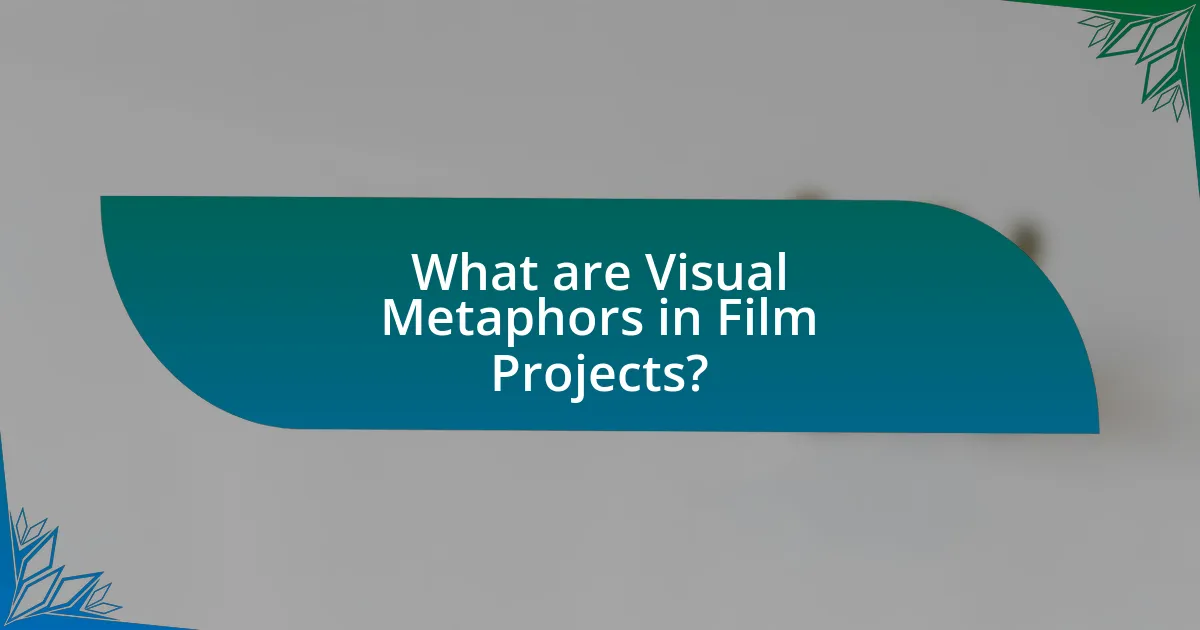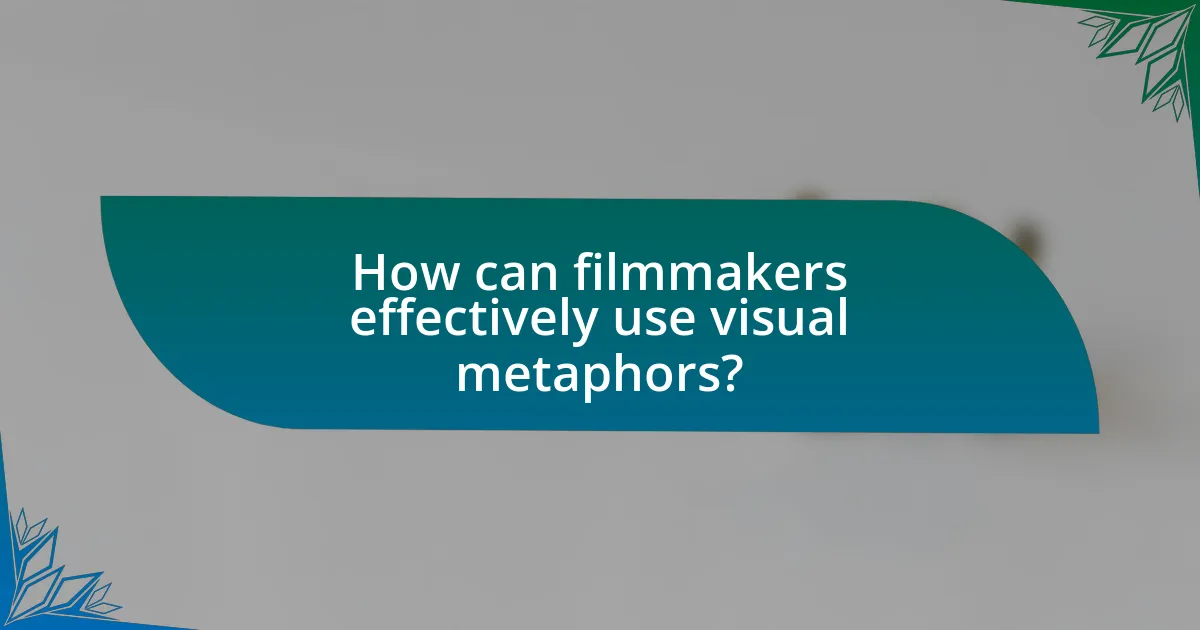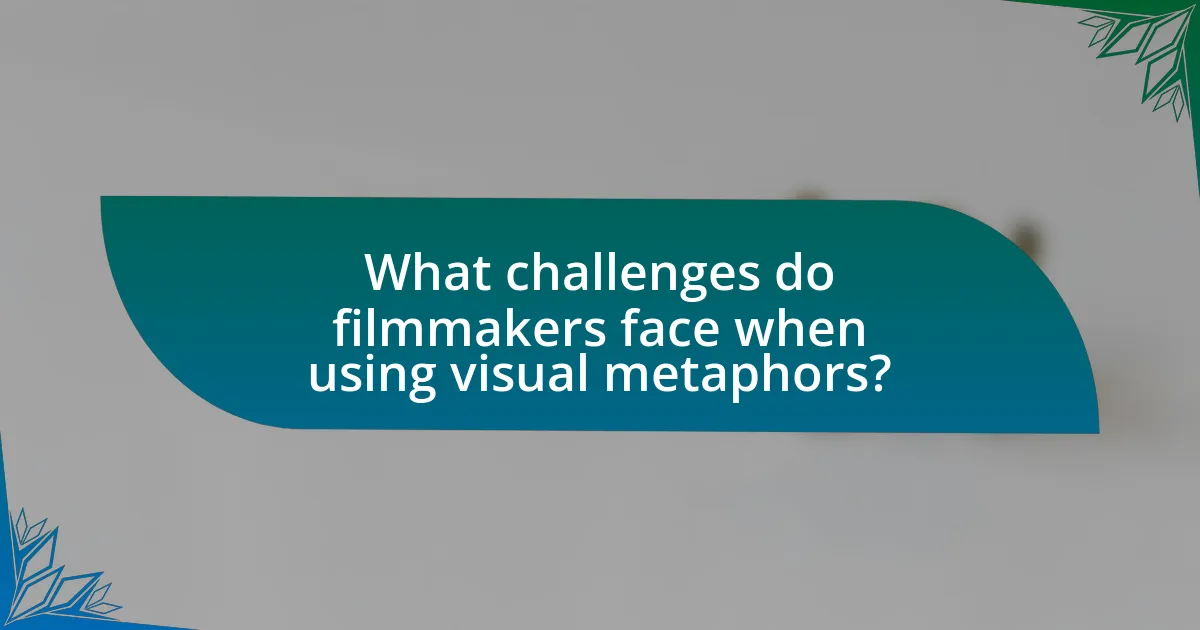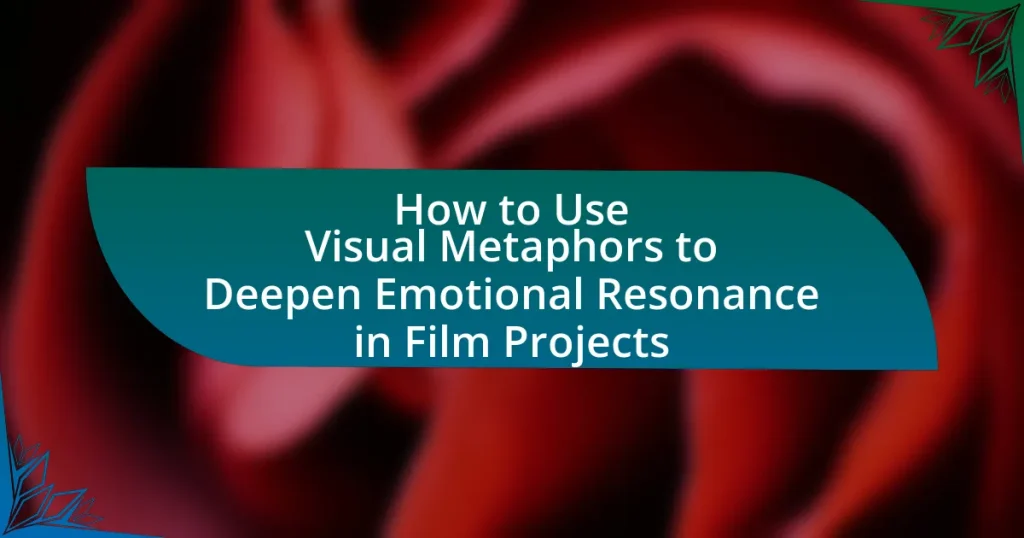Visual metaphors are symbolic images or scenes in film projects that convey deeper meanings, enhancing storytelling by visually representing themes, emotions, or character traits. This article explores how visual metaphors deepen emotional resonance in films, discussing their role in conveying complex emotions, common examples, and techniques for effective integration into narratives. It also addresses the psychological principles supporting their use, challenges filmmakers face, and best practices for clarity and cultural sensitivity. By employing visual metaphors, filmmakers can create impactful narratives that resonate emotionally with audiences, enriching the overall viewing experience.

What are Visual Metaphors in Film Projects?
Visual metaphors in film projects are symbolic images or scenes that convey deeper meanings beyond their literal interpretation. These metaphors enhance storytelling by visually representing themes, emotions, or character traits, allowing audiences to connect with the narrative on a more profound level. For instance, a character standing in the rain may symbolize sadness or turmoil, effectively communicating their emotional state without explicit dialogue. This technique has been widely utilized in cinema, as seen in films like “The Shawshank Redemption,” where the use of light and shadow serves as a metaphor for hope and despair.
How do visual metaphors enhance storytelling in films?
Visual metaphors enhance storytelling in films by providing deeper layers of meaning that resonate emotionally with the audience. These metaphors allow filmmakers to convey complex themes and emotions visually, often transcending dialogue and exposition. For instance, in the film “The Shawshank Redemption,” the recurring imagery of the bird symbolizes hope and freedom, reinforcing the protagonist’s journey. This visual representation creates a powerful emotional connection, enabling viewers to engage with the narrative on a more profound level. By utilizing visual metaphors, filmmakers can evoke feelings and insights that enrich the storytelling experience, making it more impactful and memorable.
What are some common examples of visual metaphors in cinema?
Common examples of visual metaphors in cinema include the use of rain to symbolize sadness, mirrors to represent self-reflection, and the color red to signify passion or danger. For instance, in “Blade Runner,” the recurring motif of rain enhances the film’s themes of despair and isolation. Similarly, in “Black Swan,” mirrors are employed to explore the protagonist’s duality and inner conflict. The color red in “Schindler’s List” highlights the innocence lost amidst the horrors of the Holocaust, serving as a poignant visual metaphor for the impact of violence. These examples illustrate how visual metaphors can effectively convey complex emotions and themes in film.
How do visual metaphors convey complex emotions?
Visual metaphors convey complex emotions by using imagery to represent abstract feelings, allowing audiences to grasp nuanced emotional states without explicit verbal explanation. For instance, a stormy sea can symbolize turmoil or inner conflict, while a blooming flower may represent hope or renewal. Research indicates that visual metaphors engage viewers’ cognitive processes, enabling them to interpret emotions through personal associations and experiences, thus enhancing emotional resonance in storytelling. This technique is particularly effective in film, where visual storytelling can evoke empathy and deeper understanding of characters’ emotional journeys.
Why are visual metaphors important for emotional resonance?
Visual metaphors are important for emotional resonance because they create a deeper connection between the audience and the narrative. By using imagery that symbolizes complex emotions or themes, filmmakers can evoke feelings that resonate on a subconscious level. For instance, a stormy sky can represent turmoil or conflict, allowing viewers to intuitively grasp the emotional state of characters without explicit dialogue. Research indicates that visual metaphors enhance memory retention and emotional engagement, as they activate multiple cognitive processes, making the experience more impactful. This dual engagement of visual and emotional faculties leads to a more profound understanding of the story, ultimately enriching the viewer’s experience.
How do visual metaphors connect with audience emotions?
Visual metaphors connect with audience emotions by creating symbolic representations that evoke feelings and associations beyond literal interpretations. These metaphors leverage familiar imagery to trigger emotional responses, allowing audiences to relate personal experiences to the narrative. For instance, a broken mirror can symbolize shattered dreams, prompting feelings of loss or nostalgia. Research indicates that visual metaphors enhance emotional engagement by facilitating deeper cognitive processing, as demonstrated in studies like “The Role of Metaphor in Emotion” by Thibodeau and Boroditsky, which shows that metaphorical language influences emotional perception. Thus, visual metaphors serve as powerful tools in film to resonate emotionally with viewers, enhancing their connection to the story.
What psychological principles support the use of visual metaphors?
Visual metaphors are supported by several psychological principles, including dual coding theory, cognitive load theory, and the principle of emotional resonance. Dual coding theory posits that information is better retained when presented in both verbal and visual formats, enhancing understanding and memory retention. Cognitive load theory suggests that visual metaphors can simplify complex ideas, reducing cognitive overload and facilitating easier processing of information. Additionally, the principle of emotional resonance indicates that visual metaphors can evoke strong emotional responses, making the content more relatable and impactful. Research by Paivio (1986) on dual coding and Sweller (1988) on cognitive load provides empirical support for these principles, demonstrating their effectiveness in enhancing comprehension and emotional engagement in various contexts, including film projects.

How can filmmakers effectively use visual metaphors?
Filmmakers can effectively use visual metaphors by integrating symbolic imagery that resonates with the film’s themes and characters. This technique allows filmmakers to convey complex ideas and emotions without explicit dialogue, enhancing the audience’s understanding and engagement. For instance, in “The Shawshank Redemption,” the recurring motif of the bird symbolizes freedom and hope, reflecting the protagonist’s journey. Such metaphors create layers of meaning, prompting viewers to interpret and connect with the narrative on a deeper emotional level.
What techniques can be employed to create impactful visual metaphors?
To create impactful visual metaphors, filmmakers can employ techniques such as juxtaposition, symbolism, and visual storytelling. Juxtaposition involves placing contrasting images side by side to highlight differences and create deeper meaning, as seen in films like “The Godfather,” where light and dark imagery represent moral conflict. Symbolism uses objects or colors to represent larger concepts; for example, a broken mirror can symbolize shattered identity. Visual storytelling focuses on conveying emotions and themes through imagery rather than dialogue, effectively engaging the audience’s imagination and emotions. These techniques enhance the emotional resonance of film projects by allowing viewers to connect with underlying themes on a more profound level.
How does color symbolism play a role in visual metaphors?
Color symbolism significantly enhances visual metaphors by conveying emotions and themes without explicit narration. For instance, the color red often symbolizes passion or danger, while blue can represent calmness or sadness. This use of color allows filmmakers to evoke specific feelings and associations in the audience, enriching the narrative. Research indicates that colors can trigger emotional responses; for example, a study published in the journal “Color Research and Application” found that colors can influence mood and perception, supporting the idea that color choices in visual metaphors can deepen emotional resonance in film projects.
What role does composition and framing have in visual metaphor creation?
Composition and framing play a crucial role in visual metaphor creation by guiding the viewer’s perception and emotional response. Effective composition arranges elements within the frame to create relationships and contrasts that enhance the metaphor’s meaning. For instance, placing a character in a confined space can symbolize emotional isolation, while an expansive landscape can evoke freedom. Framing, on the other hand, directs attention to specific elements, emphasizing their significance in conveying the metaphor. Research indicates that visual metaphors are more impactful when composition and framing align with the intended emotional narrative, as they help establish context and deepen viewer engagement.
How can visual metaphors be integrated into a film’s narrative?
Visual metaphors can be integrated into a film’s narrative by using symbolic imagery that conveys deeper meanings related to the characters’ emotions or themes. For instance, a character’s journey through a stormy sea can represent their internal struggles, effectively linking visual elements to narrative arcs. This technique enhances storytelling by allowing viewers to interpret complex ideas visually, thereby deepening emotional engagement. Research indicates that films employing visual metaphors, such as “The Tree of Life” by Terrence Malick, successfully evoke emotional responses through their rich imagery, demonstrating the effectiveness of this approach in cinematic storytelling.
What are the best practices for introducing visual metaphors?
The best practices for introducing visual metaphors include ensuring clarity, relevance, and emotional alignment with the narrative. Clarity is essential; the metaphor should be easily recognizable to the audience to avoid confusion. Relevance ensures that the metaphor connects meaningfully to the themes or characters, enhancing the storytelling. Emotional alignment means that the metaphor should evoke feelings that resonate with the audience’s experiences or the film’s emotional tone. For instance, in the film “The Shape of Water,” the use of water as a metaphor for love and connection is both clear and relevant, deepening the emotional impact of the story.
How can visual metaphors be used to foreshadow events in a film?
Visual metaphors can foreshadow events in a film by symbolically representing future plot developments through imagery that resonates with the audience. For instance, a recurring image of a wilting flower may suggest impending loss or decay, subtly preparing viewers for a character’s tragic fate. This technique leverages the audience’s ability to interpret visual cues, creating an emotional connection that enhances narrative depth. Studies in film theory, such as those by David Bordwell, emphasize that visual metaphors serve as a narrative device that can guide audience expectations and emotional responses, thereby reinforcing the thematic elements of the story.

What challenges do filmmakers face when using visual metaphors?
Filmmakers face several challenges when using visual metaphors, primarily related to audience interpretation and clarity of message. The subjective nature of visual metaphors can lead to varied interpretations, making it difficult for filmmakers to ensure that their intended meaning is conveyed effectively. Additionally, filmmakers must balance creativity with coherence; overly complex or obscure metaphors may confuse viewers rather than enhance understanding. Furthermore, cultural differences can impact how metaphors are perceived, as symbols may carry different meanings across diverse audiences. These challenges necessitate careful consideration and testing to achieve the desired emotional resonance without alienating viewers.
How can misinterpretation of visual metaphors be avoided?
Misinterpretation of visual metaphors can be avoided by ensuring clarity in the imagery and context presented. Clear visual cues, consistent thematic elements, and audience testing can enhance understanding. Research indicates that visual metaphors are more effectively interpreted when they align closely with the narrative context, as demonstrated in studies on visual communication, such as those by Forceville (2006) in “Pictorial Metaphor in Advertising,” which highlights the importance of contextual relevance in metaphor comprehension.
What strategies can be used to ensure clarity in visual metaphors?
To ensure clarity in visual metaphors, filmmakers should utilize straightforward imagery that aligns closely with the intended message. This involves selecting symbols that are universally recognized and easily interpreted by the audience, thereby minimizing ambiguity. For instance, using a broken chain to represent freedom is a clear metaphor that most viewers can understand without confusion. Additionally, maintaining consistency in visual style and context throughout the film reinforces the metaphor’s meaning, as seen in films like “The Shawshank Redemption,” where the recurring motif of the prison bars effectively symbolizes confinement and hope. By employing these strategies, filmmakers can enhance the emotional impact of their visual metaphors, ensuring that the audience grasps the intended significance.
How can filmmakers balance subtlety and clarity in visual metaphors?
Filmmakers can balance subtlety and clarity in visual metaphors by carefully selecting imagery that resonates with the audience while ensuring the metaphor’s meaning is accessible. This involves using symbols that are universally understood, such as a broken clock to represent lost time, which allows viewers to grasp the intended message without overt explanation. Additionally, filmmakers can employ visual cues that complement the narrative context, enhancing the metaphor’s impact without overwhelming the viewer. For instance, in “The Great Gatsby,” the green light symbolizes hope and unattainable dreams, effectively conveying complex themes through a simple visual element. This approach ensures that the metaphor remains poignant yet clear, facilitating emotional engagement without sacrificing depth.
What are some common pitfalls in using visual metaphors?
Common pitfalls in using visual metaphors include overcomplication, misalignment with the narrative, and cultural misinterpretation. Overcomplication occurs when metaphors are too intricate, leading to confusion rather than clarity. Misalignment with the narrative happens when the metaphor does not support or enhance the story, resulting in a disjointed viewer experience. Cultural misinterpretation arises when a metaphor is based on cultural references that may not resonate universally, potentially alienating audiences. These pitfalls can detract from the intended emotional impact of the film, making it crucial for filmmakers to carefully consider their visual metaphor choices.
How can overuse of visual metaphors detract from a film’s message?
Overuse of visual metaphors can detract from a film’s message by overwhelming the audience and obscuring the intended narrative. When filmmakers excessively rely on visual metaphors, they risk diluting the clarity of the story, leading to confusion rather than insight. For instance, a study by the University of Southern California found that films with too many complex visual symbols can cause viewers to misinterpret key themes, as the cognitive load increases and distracts from the primary message. This indicates that while visual metaphors can enhance storytelling, their overuse can ultimately hinder effective communication in film.
What are the risks of cultural misinterpretation in visual metaphors?
Cultural misinterpretation in visual metaphors poses significant risks, including the potential for offense, misunderstanding, and alienation of audiences. When visual metaphors are derived from specific cultural contexts, they may not translate effectively across different cultures, leading to interpretations that diverge from the creator’s intent. For instance, a symbol that is positive in one culture may be negative or neutral in another, resulting in confusion or backlash. Research indicates that 70% of global audiences may misinterpret visual content due to cultural differences, highlighting the importance of cultural sensitivity in visual storytelling.
What practical tips can filmmakers follow to enhance emotional resonance through visual metaphors?
Filmmakers can enhance emotional resonance through visual metaphors by carefully selecting imagery that aligns with the characters’ emotional journeys. For instance, using a wilting flower to symbolize a character’s fading hope can create a powerful connection with the audience. Additionally, filmmakers should consider the context of the metaphor; for example, a stormy sky can represent internal conflict, making the emotional stakes clearer.
Moreover, consistency in visual metaphors throughout the film reinforces their impact; if a specific metaphor is introduced early, revisiting it later can evoke stronger emotional responses. Research indicates that visual metaphors can significantly influence audience engagement and emotional reactions, as they allow viewers to interpret and connect with the narrative on a deeper level. By integrating these strategies, filmmakers can effectively utilize visual metaphors to deepen emotional resonance in their projects.


